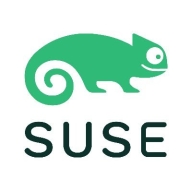


Chef and SUSE Manager are both valuable tools for IT infrastructure management. SUSE Manager seems to have a slight edge in terms of comprehensive feature sets tailored for enterprise environments.
Features: Chef users value its wide range of automation capabilities, integration with various platforms, and extensive ecosystem. SUSE Manager is praised for its system management, patching capabilities, and compliance features.
Room for Improvement: Chef users note the need for enhancing reporting capabilities, reducing the complexity of initial configurations, and streamlining processes. SUSE Manager users suggest improvements in scalability, interface responsiveness, and performance under heavy workloads.
Ease of Deployment and Customer Service: Chef is appreciated for its clear documentation and community support, making it easier for smaller teams to deploy. SUSE Manager's deployment is smoother in enterprise environments, with strong customer service support. SUSE Manager users find the setup process more straightforward compared to Chef’s complex initial deployment.
Pricing and ROI: Chef users find the tool competitively priced, offering good ROI for smaller to mid-sized companies. SUSE Manager, although perceived as pricier, is viewed as worth the investment due to its extensive feature set and reliability in large-scale deployments. Users feel that Chef provides cost-effective solutions, while SUSE Manager offers higher ROI for extensive enterprise needs.
Everything we've gained from it makes my job easier day after day, and I see value in it as an engineer.
Importantly, when someone leaves the company, it helps protect document access on their devices.
Applications are deployed through Intune, and we see fewer tickets for common issues because we can resolve them through the solution.
When a support ticket is submitted, it directly reaches someone with Intune support expertise.
When I contacted Microsoft, they had the same expertise, if not more, which is phenomenal because I felt heard and my problem was solved.
Sometimes, the support provided is excellent, and the representative is knowledgeable, while other times, the service needs improvement.
Generally, the support is good, but there are instances where the support team seems disinterested in solving complex problems.
The scalability of Microsoft Intune is ten out of ten.
Ideally, we want to automatically segregate devices based on user properties like primary use, but currently, dynamic groups seem limited to device properties.
It supports organizations with 200 endpoints and those with more than 15,000 endpoints.
We have not experienced downtime, bugs, or glitches.
Microsoft Intune has been very stable.
A couple of years ago, the performance was not as good as it is now, but there are noticeable backend improvements.
The stability of SUSE Manager is fine.
Features like unlocking devices sometimes fail, and the support offered for other operating systems is insufficient.
There are communication issues, so you might start working with a feature without knowing if it will be deprecated six months from now.
Many third-party companies offer single-pane-of-glass reporting that shows you what your update environment looks like, how your patch is doing, application status, etc., but Intune's reporting is not intuitive.
A better description of the initial setup process could enhance user experience.
Features that can be helpful in disaster recovery.
From an integration perspective, it is difficult to integrate with Jira or any ticketing tool, which is challenging.
Introductory professional services, like a fast-track service, were included with our E5 membership, and there have been no additional costs.
The Intune suite and add-ons, such as batch management and remote help, are costly.
It costs approximately forty euros per user per month.
Intune excels in configuration and compliance management for Windows 10, ensuring devices receive timely updates and adhere to organizational standards.
Dynamic groups allow us to set conditions for automatic membership, eliminating the need for user intervention or manual review and ensuring a seamless workflow.
Windows Autopatch is the most valuable because it removes the burden of patch management.
It supports more than six or seven Linux flavors, and when compared to other tools such as Satellite, which only supports the Red Hat operating system, SUSE Manager supports Red Hat, Ubuntu, Debian, and some other Linux operating systems for patch management.
SUSE Manager is valuable for managing systems, patching, and utilizing SaltStack connectivity for various installations and other routines.



Microsoft Intune provides centralized management of mobile devices and applications, ensuring security, compliance, and productivity through integration with Microsoft services like Microsoft 365 and Azure Active Directory.
Organizations use Intune for managing mobile devices and applications, enhancing security and compliance across platforms. With features like single sign-on, conditional access, and zero-touch deployment via Autopilot, it facilitates efficient operations. Intune's scalability, easy enrollment, and capabilities such as remote wipe support diverse device management, offering robust data protection and efficient operation. Despite its features, improvement areas include reporting, compatibility with non-Microsoft devices, and better support for macOS and Linux devices.
What are the key features of Microsoft Intune?
What benefits should users look for in reviews?
In industries such as finance, healthcare, and education, Microsoft Intune is implemented to ensure secure and compliant device management. Companies leverage its capabilities to deploy security policies and manage both corporate-owned and BYOD environments, facilitating a unified approach to data protection and compliance.
Chef, is the leader in DevOps, driving collaboration through code to automate infrastructure, security, compliance and applications. Chef provides a single path to production making it faster and safer to add value to applications and meet the demands of the customer. Deployed broadly in production by the Global 5000 and used by more than half of the Fortune 500, Chef develops 100 percent of its software as open source under the Apache 2.0 license with no restrictions on its use. Chef Enterprise Automation Stack™, a commercial distribution, is developed solely from that open source code and unifies security, compliance, infrastructure and application automation with observability. Chef provides an unequaled developer experience for the Coded Enterprise by enabling users to express infrastructure, security policies and the application lifecycle as code, modernizing development, packaging and delivery of any application to any platform. For more information, visit http://chef.io and follow @chef.
SUSE Manager was designed to help your enterprise DevOps and IT Operations teams reduce complexity and regain control of your IT assets with a single tool to manage Linux systems across a variety of hardware architectures, hypervisors as well as container, IoT and cloud platforms. It automates Linux server and IoT device provisioning, patching and configuration for faster, consistent and repeatable server deployment helping to optimize operations and reduce costs. And with automated monitoring, tracking, auditing and reporting of your systems, VMs, and containers across your development, test and production environments, you can ensure compliance with internal security policies and external regulations.
We monitor all Configuration Management reviews to prevent fraudulent reviews and keep review quality high. We do not post reviews by company employees or direct competitors. We validate each review for authenticity via cross-reference with LinkedIn, and personal follow-up with the reviewer when necessary.